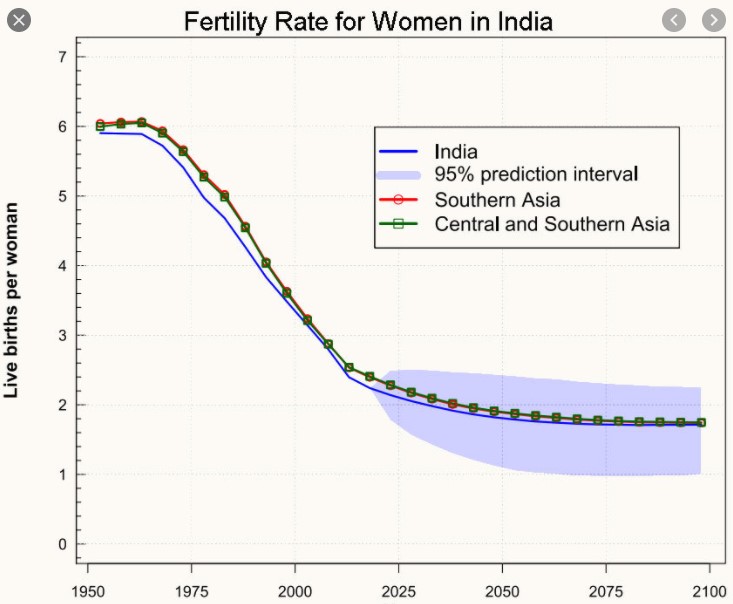Focus: GS-II Governance
Introduction
A new study argues that while India is destined to be the largest country in the world, its population will peak by mid-century and as the 21st century closes, its ultimate population will be far smaller than anyone could have anticipated, about 1.09 billion instead of approximately 1.35 billion today.
Fertility rate prediction
The study predicts that by the year 2100, on average, Indian women will have 1.29 children.
Since each woman must have two children to replace herself and her husband, this will result in a sharp population decline.
- In contrast to the predicted 1.29 children rate for India, the study projected cohort fertility of 1.53 for the United States and 1.78 for France in the same model (both significantly higher than India).
The Contrast in the second half
- The United Nations projects that India’s population will be 1.64 billion by 2050 and the IHME projects 1.61 billion by 2048 (quite similar projections).
- In the second half of the century the two projections diverge with the UN predicting a population of 1.45 billion by 2100, and the IHME, 1.09 billion.
Reason for divergence?
- Part of this divergence may come from IHME model’s excessive reliance on data regarding current contraceptive use in the National Family Health Survey (NFHS) and potential for increasing contraceptive use.
- Research at the National Council of Applied Economic Research (NCAER) National Data Innovation Centre by Santanu Pramanik and colleagues shows that contraceptive use in the NFHS is poorly estimated, and as a result, unmet need for contraception may be lower than that estimated by the IHME model, generating implausibly low fertility projections for 2100.
Fertility decline
- Regardless of which projection we consider, India’s demographic future contains a peaking and subsequently declining population driven by a sharp reduction in fertility.
- In the 1950s, India’s Total fertility rate (TFR) was nearly 6 children per woman, today it is 2.2.

What did NOT accelerate fertility decline?
- Family planning has long lost its primacy in the Indian policy discourse.
- Between 1975 and 1994, family planning workers had targets they were expected to meet regarding sterilisations, condom distribution and intrauterine device (IUD) insertion and often these targets led to explicit or implicit coercion.
- The stick of policies designed to punish people with large families has been largely ineffective.
Punitive policies include denial of maternity leave for third and subsequent births, limiting benefits of maternity schemes and ineligibility to contest in local body elections for individuals with large families.
What accelerated fertility decline?
- It seems highly probable that the socioeconomic transformation of India since the 1990s has played an important role.
- Over this period, agriculture became an increasingly smaller part of the Indian economy, school and college enrolment grew sharply and individuals lucky enough to find a job in government, multinationals or software services companies reaped tremendous financial benefits.
- Hence, parents began to rethink their family-building strategies.
Retreat from family?
The literature on fertility decline in western countries attributes the decline in fertility to retreat from the family, however, Indian parents seem to demonstrate increased rather than decreased commitment to family by reducing the number of children and investing more in each child.
Way Forward
- Demographic data suggest that the aspirational revolution is already under way.
- What we need to hasten the fertility decline is to ensure that the health and family welfare system is up to this challenge and provides contraception and sexual and reproductive health services that allow individuals to have only as many children as they want.
-Source: The Hindu



